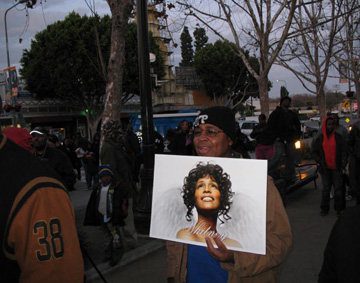 The sound of Whitney Houston’s voice blared over speakers in Leimert park as people danced and sang along during a vigil in her memory on Monday night.
The sound of Whitney Houston’s voice blared over speakers in Leimert park as people danced and sang along during a vigil in her memory on Monday night.
“She sang songs that were uplifting, she sang songs about real life, she sang songs that were moving, that would move people,” says Tyronne Alonzo Rouege, who has followed Houston’s career from the beginning.
While some of the fans celebrated her life, others were overwhelmed.
“I can’t believe she’s gone. It’s very emotional that’s my favorite song they’re playing,” weeps Adinett Nsabimana. “I couldn’t believe it. I just read something about her two days before. She was going to perform for Clive Davis that night and she left right before the Grammys. Just like Michael Jackson died before his comeback.”
 Fans lit candles in memory of the iconic singer. Some embraced each other, expressing their sorrow and disbelief at Whitney’s death.
Fans lit candles in memory of the iconic singer. Some embraced each other, expressing their sorrow and disbelief at Whitney’s death.
“I still can’t believe it. It’s still surreal to me,” says Danny Woods, a blues singer who admired the pop star. “But she’s a living legend that will never go. Her voice is forever.”
Fans at Leimert Park vigil didn’t want to talk about the superstar’s erratic behavior during her final days. They say they want to remember her as a beautiful icon and the legend she has now become.
“She’s known for her talent and that’s something that no one can take away from her,” says Woods. “It’s sad to say, but I think she was a victim of her talent.”









 Parents gathered last week to protest the school’s reopening with an entirely new staff.
Parents gathered last week to protest the school’s reopening with an entirely new staff. Mark Berndt, 61, was arrested in January on suspicion of committing lewd acts upon a child.
Mark Berndt, 61, was arrested in January on suspicion of committing lewd acts upon a child. Martin Springer, another teacher at Miramonte, was arrested four days after Mark Berndt.
Martin Springer, another teacher at Miramonte, was arrested four days after Mark Berndt.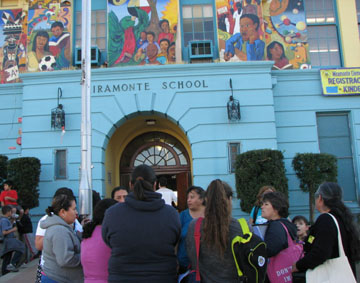




 Parents congregate outside Miramonte Elementary school last week after meeting with school officials.
Parents congregate outside Miramonte Elementary school last week after meeting with school officials.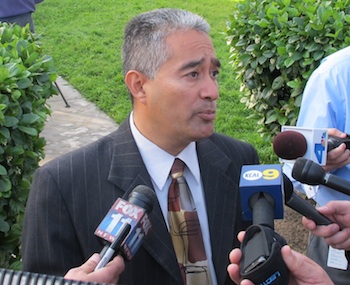 Miramonte Elementary principal Martín Sandoval talked to reporters the day after the arrest of teacher Mark Berndt.
Miramonte Elementary principal Martín Sandoval talked to reporters the day after the arrest of teacher Mark Berndt.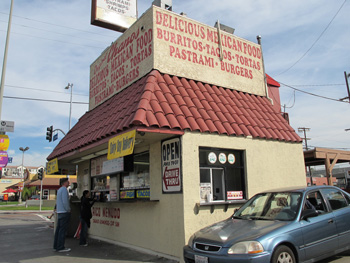 Customers order at Chano’s original “shack.”
Customers order at Chano’s original “shack.” Don and Christina Macías, in front of the original Chano’s “shack.”
Don and Christina Macías, in front of the original Chano’s “shack.” John Macías, at Chano’s second location on 3850 S. Figueroa St.
John Macías, at Chano’s second location on 3850 S. Figueroa St. Chano’s invested in an electric car to make deliveries.
Chano’s invested in an electric car to make deliveries. Chano’s now offers a popular vegetarian menu.
Chano’s now offers a popular vegetarian menu. Chano’s second location at 3850 S. Figueroa St.
Chano’s second location at 3850 S. Figueroa St.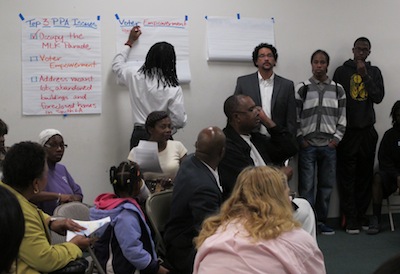 Alberto Retana listens to ideas from community members.
Alberto Retana listens to ideas from community members.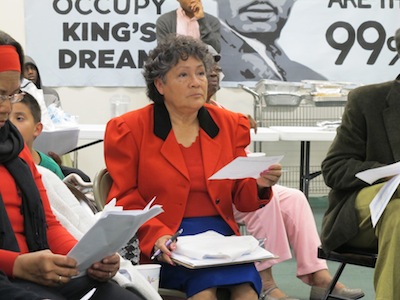 Carla Vega, a dedicated volunteer, signed up to be in the People Power Assembly Committee.
Carla Vega, a dedicated volunteer, signed up to be in the People Power Assembly Committee.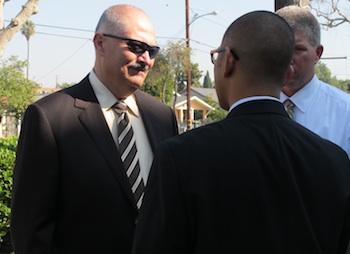 Lt. Marquez from the LA Sheriff’s Special Victims Unit speaks with other investigators at Miramonte Elementary.
Lt. Marquez from the LA Sheriff’s Special Victims Unit speaks with other investigators at Miramonte Elementary. Mark Berndt, 61, a teacher at Miramonte Elementary for 30 years, is in jail on $23 million bail.
Mark Berndt, 61, a teacher at Miramonte Elementary for 30 years, is in jail on $23 million bail.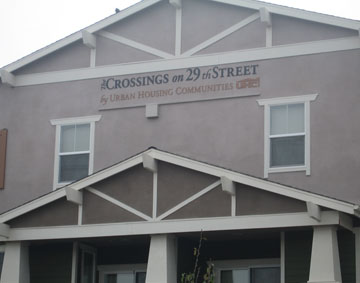 Unless alternative funding can be found, the next phase of the Crossings at 29th street, an affordable housing project in district 9 will come to a halt.
Unless alternative funding can be found, the next phase of the Crossings at 29th street, an affordable housing project in district 9 will come to a halt.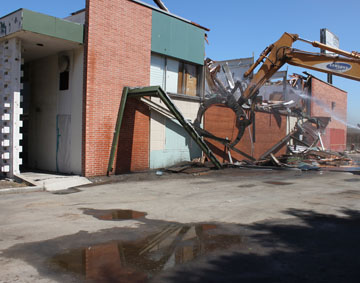 Marlton Square, in district 8, was in redevelopment limbo for 20 years. Demolition finally started in 2011, but now its future is uncertain.
Marlton Square, in district 8, was in redevelopment limbo for 20 years. Demolition finally started in 2011, but now its future is uncertain. According to Sgt. Dan Scott of the sheriff’s Special Victims Bureau, Berndt had been a teacher at Miramonte Elementary School, located at 1400 E. 68th St. for more than 30 years.
According to Sgt. Dan Scott of the sheriff’s Special Victims Bureau, Berndt had been a teacher at Miramonte Elementary School, located at 1400 E. 68th St. for more than 30 years.  This is the notice parents received on Tuesday, January 31, the day after teacher Mark Berndt was arrested.
This is the notice parents received on Tuesday, January 31, the day after teacher Mark Berndt was arrested. Los Angeles City Controller and mayoral candidate Wendy Greuel was the guest speaker of the first Urban Issues Breakfast Forum of 2012 held this morning, hosted by Dr. Anthony Asadullah Samad. Titled “Moving toward accountable Government. Who are the real watchdogs,” Greuel was invited to address issues of wasteful spending in the L.A. City government.
Los Angeles City Controller and mayoral candidate Wendy Greuel was the guest speaker of the first Urban Issues Breakfast Forum of 2012 held this morning, hosted by Dr. Anthony Asadullah Samad. Titled “Moving toward accountable Government. Who are the real watchdogs,” Greuel was invited to address issues of wasteful spending in the L.A. City government. 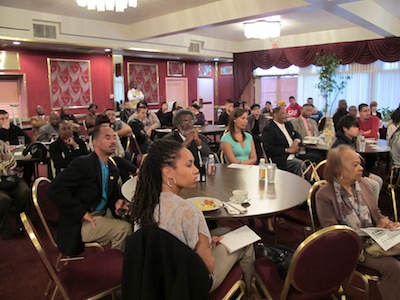 Greuel listened attentively as community members lined up to ask her a variety of questions. When one woman told her she had seen a parking lot full of unused police cars collecting dust, the controller promised to look into it. Among the questions askes: what has shocked her most as controller, why she was running for mayor, what she would do about the Crenshaw metro line if she were elected, and if she thought the City Council should have more members to adequately represent constituents.
Greuel listened attentively as community members lined up to ask her a variety of questions. When one woman told her she had seen a parking lot full of unused police cars collecting dust, the controller promised to look into it. Among the questions askes: what has shocked her most as controller, why she was running for mayor, what she would do about the Crenshaw metro line if she were elected, and if she thought the City Council should have more members to adequately represent constituents.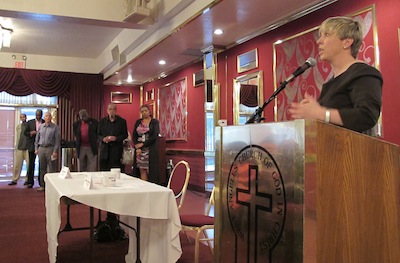 As to why she’s running for mayor, she replied: “Nothing comes easy and if you believe, it’s worth taking a risk…. I’m doing it because I think I have the experience to get the job done. In the meantime, I’m going to be the best controller ever.”
As to why she’s running for mayor, she replied: “Nothing comes easy and if you believe, it’s worth taking a risk…. I’m doing it because I think I have the experience to get the job done. In the meantime, I’m going to be the best controller ever.”




